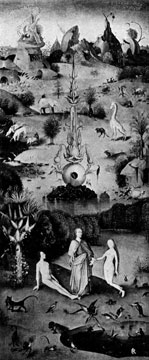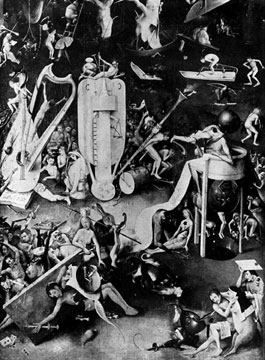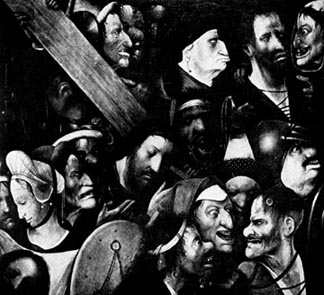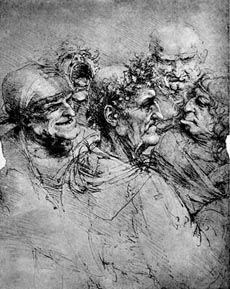
Home | Search | About | Fidelio | Economy | Strategy | Justice | Conferences | Links
LaRouche | Music | Join | Books | Concerts | Highlights | Education | Health
Spanish Pages | Poetry | Dialogue of Cultures | Maps
What's New
The Painter Hieronymous Bosch:
Was He a Pornographer
or a Moralist?
by Bonnie James
from the July 5, 2004 The New Federalist
Related Pages
Suddenly, everyone is talking about the great 15th-Century Netherlandish painter Hieronymous Bosch (1450-1516), and what they are saying is not always nice. Unlike the “Bosch-mania” that swept Europe in 2001, when a major exhibition of his works was shown in Rotterdam, this time, what has grabbed people's attention, is the provocative cover on the LaRouche in 2004 campaign pamphlet, “Children of Satan III: the Sexual Congress for Cultural Fascism” (see ad, page 8). There, in full color, is a detail from Bosch's masterpiece, The Garden of Earthly Delights, painted c. 1500.
One LaRouche supporter, who had enthusiastically distributed the first two “Children of Satan” pamphlets, issued in April 2003 and January 2004, protested to an organizer that the cover of number III was “pornographic.” This person had begun removing the offensive cover, before handing them out. Other organizers have reported similar reactions to the cover picture, which depicts naked men and women engaging is all sorts of behaviors, foolish and profane, but also hilarious. “How,” asked one person, “could LaRouche have approved something so shameful for the cover of this pamphlet?”
Perhaps people would be surprised to learn that the artist who painted The Garden of Earthly Delights was a man of deep faith, and a member of a Christian lay order known as the Brotherhood of Notre Dame (Our Lady), a group associated with one of the most important teaching orders of the early Renaissance, the Brothers and Sisters of the Common Life. The brotherhood, which originated in Holland in the late 14th Century, advocated a personal form of religious devotion called the Devotio Moderna, elaborated in Thomas à Kempis's Imitation of Christ. This reform movement, with which Bosch was associated, believed in universal education; that by educating even the children of the poor to read, as the Brothers of the Common Life did, each person could develop his or her own power to know God, to take responsibility for the consequences of his actions, and to engage in a process of self-perfection, in imitation of Christ.
What Bosch so powerfully and humorously depicts in his work, are precisely those follies and foibles that prevent us from realizing our true nature as man made in the image of God—imago Dei. Bosch forces us to choose: Are you a man or a beast?
- A Time of Contrasts -
Bosch lived in an historical period full of paradoxes, contrasts, and contradictions (much like our own!). It was the world of the Golden Renaissance. His life was almost exactly contemporaneous with that of the greatest genius of the 15th-Century Golden Renaissance, Leonardo da Vinci (1452-1519). Out of the horror of the 14th-Century Dark Age, the great minds of the early Renaissance—Brunelleschi, Cusa, and others—created the Renaissance in Florence. The early Renaissance also established itself in Flanders, with the work of painters like Robert Campin and Jan van Eyck.
At the same time, during the 15th Century, the power of the Holy Office, also known as the Inquisition, had imposed a reign of terror in Europe. In Spain, with Austria the seat of the Holy Roman Empire, which ruled over the Netherlands, their Most Catholic Majesties, Ferdinand and Isabella, were enforcing the will of the Grand Inquisitor with hot religious fervor. In January of 1492, the Reconquista crushed the last outpost, in the fortress city of Granada, of the more than 700-year-old Islamic civilization of the poetically named al-Andalus; in August, the Expulsion Order against the Jews of Spain became final; and throughout Europe, fear of the Holy Office and its bonfires spread—bonfires in which the books of the “infidels,” and often their bodies as well, were consumed in the flames. Just 20 years before Bosch's birth, Joan of Arc was martyred in just this way.
Hieronymus (Jerome, in English) lived and worked in the small Dutch city of s'Hertogenbosch, in the province of Brabant, near the border of today's Belgium; his family had emigrated from Aachen, in Germany. Both his father and a brother were painters, as was his grandfather. It is likely that Hieromymus's German ancestors were employed in the building and decorating of the beautiful Gothic Cathedral of St. John's in s'Hertogenbosch, whose construction had begun around the time they arrived in the city.
By the middle of the 15th Century, when Hieronymus was born, s'Hertogenbosch was a thriving commercial town, in the center of an agricultural region, with extensive trade links throughout Northern Europe and to Italy. The city, which produced cloth, was especially known for its organ and bell-making industries. It also boasted a famous Latin school, and by the end of the 15th Century, there were five schools of rhetoric, or literary associations, which presented poetic and dramatic performances on public occasions. It is likely that Bosch never travelled far from home, and almost certainly, never beyond the Netherlands.
This then, in brief, is the environment in which Bosch lived and worked. - 'The Vanity of the World' -
The Garden of Earthly Delights, which was called, in early inventories, “The Vanity of the World,” is a panoramic triptych (three-part panel painting); the left wing shows the Garden of Eden (Figure 1), in which God the Father has just created Eve, and taking her hand, seems to be introducing her to Adam. Unlike more familiar depictions of this subject, this Garden of Eden, on closer inspection, is not an idyllic place; there are disturbing activities going on, amid strange shapes, fanciful beasts, hinting at the Fall that is to come. Notice the cat in the foreground, carrying off a mouse in her mouth.
The right wing of the triptych shows Hell (Figure 2, detail)—not the blazing fires of Hell that we usually think of—but a dark, frozen place, dead, yet filled with objects from everyday life, like the dice, playing cards, etc., easily associated with sin. A brawl has broken out among the gamblers, and its victims are carried off by devils. Other objects, such as the over-sized musical instruments, Bosch suggests, can also be used sinfully, if you let them dominate your life. It's a question of intention.
The central panel, “The Sinful Descendants of Adam” (from which the detail shown on the cover of “Children of Satan III” is taken) shows man in “Earthly Paradise,” that is, man as beast, indulging in all the pleasures of the flesh: illicit sex, gluttony, and so forth. The recurring image of the luscious strawberry—fruit from the Garden of Eden—symbolizes the ephemeral nature of sensual pleasure.
Is this a dark vision, in which man is trapped, with no way out? Or does Bosch tell us, humorously, ironically, that it is up to us to choose between Good and Evil? Look at some of the details, such as the one (from the pamphlet cover) showing flowers being planted (or growing from) the rear-end of some hapless fellow. What are we to make of this? Is this a terrifying vision of the afterlife, or is Bosch ridiculing our attachment to sensual pleasure, by making us laugh at ourselves?
- Man or Beast -
In “Christ Carrying the Cross” (c. 1490) (Figure 3) Bosch shows Christ, at the center, struggling under his heavy burden, among a sea of grotesque faces (with the exception of the woman on the left, sometimes identified as St. Veronica), men who are oblivious to his suffering. This is the face of evil, the children of Satan. This is what man becomes without love of the Good.
Leonardo saw this too. Though the two never met, as we have seen, Bosch would have had access to drawings and copies of paintings from Italy, through the trade conducted between s'Hertogenbosch and that country beyond the Alps. We don't know whether he ever saw Leonardo's drawing of “Five Grotesque Heads” (Figure 4) but we can be sure that both artists understood that the Renaissance would be crushed, unless man were uplifted from his bestial condition, to become man in the image of God.
Bosch has been called a pessimist, an alchemist, a blasphemer, a man who could not see the possibility of redemption—even, a pornographer. Is he any of these? Or is he waging a ruthless polemic against the same kind of evil we face today: the evil represented by the “Sexual Congress for Cultural Fascism”? Like Bosch's challenge to his fellow man: You have the power to choose between Good and Evil. You are responsible for your fate. Will you choose “Earthly delights”? Or will you refuse to be a beast, and find your own immortality in devoting your life to a higher purpose?
|
Figures |
|||
 |
 |
||||||||||||||
| Figure 1: (left) In 'The Garden of Eden,' the left panel of the triptych, God the Father has just created Eve. The scene is filled with ominous warnings of the Fall to come. back to article |
|||||||||||||||
| Figure 2: (right) The right panel shows a Hell, not of fire, but frozen and dead, as the damned are tortured by the objects of everyday life. back to article |
|||||||||||||||
| Figure 3: (below) Bosch's Christ Carrying the Cross is a ferocious attack on the bestiality of those who fail to act on behalf of the Good. back to article |
Figure 4: (below) Leonardo da Vinci's study of 'Five Grotesque Heads' indicates that he too was fighting to pull mankind out of the Hell of the senses. back to article |
||||||||||||||
 |
 |
||||||||||||||
What is the Schiller Institute?
Eurasian Landbridge and Economy
Writings of Other Great Thinkers
![]()
schiller@schillerinstitute.org
The Schiller Institute
PO BOX 20244
Washington, DC 20041-0244
703-297-8368
Thank you for supporting the Schiller Institute. Your membership and contributions enable us to publish FIDELIO Magazine, and to sponsor concerts, conferences, and other activities which represent critical interventions into the policy making and cultural life of the nation and the world.
Contributions and memberships are not tax-deductible.
VISIT THESE OTHER PAGES:
Home | Search | About | Fidelio | Economy | Strategy | Justice | Conferences | Links
LaRouche | Music | Join | Books | Concerts | Highlights | Education | Health
Spanish Pages | Poetry | Dialogue of Cultures | Maps
What's New
© Copyright Schiller Institute, Inc. 2004. All Rights Reserved.